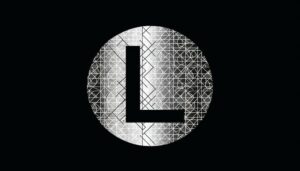How Does a Cross Inside a Triangle Symbol Represent Meaning in Various Cultures?
The cross inside a triangle symbol carries deep historical, spiritual, and philosophical significance. It dates back to ancient civilizations, where it symbolized the trinity of gods and creation.
In Christianity, it represents the Holy Trinity and Christ's crucifixion. Alchemically, it denotes the synthesis of elements and the pursuit of the philosopher's stone.
In Freemasonry, it signifies triadic harmony and moral rectitude. Modern interpretations range from abstract art to design and branding, reflecting its universal resonance.
Its geometric simplicity embodies complex meanings, inviting introspection and contemplation. Exploring its rich tapestry of interpretations can provide deeper insights into cultural and personal symbolism.
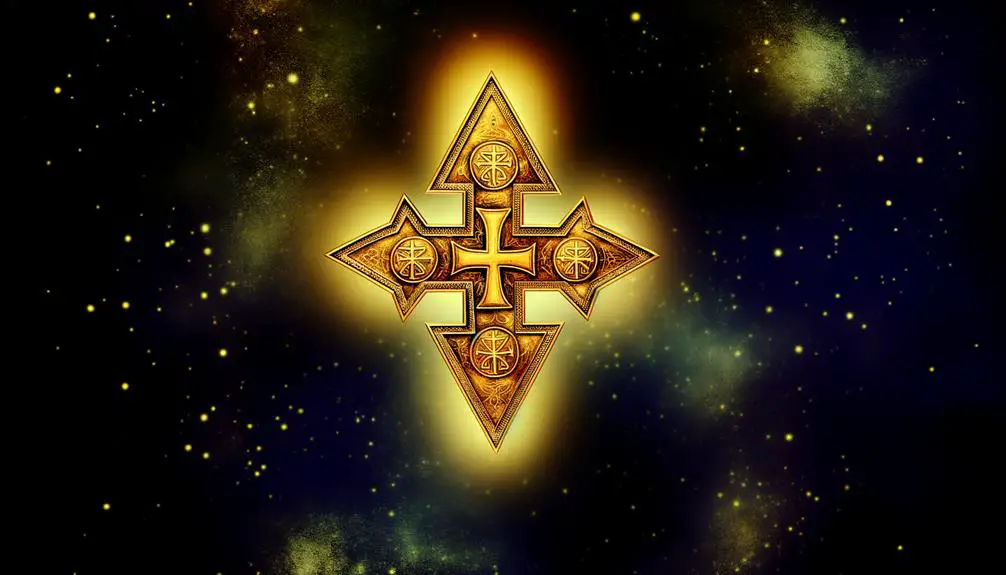
Key Takeaways
- The cross inside a triangle symbolizes the Holy Trinity in Christianity, representing the Father, Son, and Holy Spirit.
- In Freemasonry, it embodies esoteric knowledge, moral rectitude, and the reconciliation of material and spiritual pursuits.
- Alchemically, it represents the synthesis of elements and the pursuit of the philosopher's stone.
- The symbol integrates physical and spiritual elements, suggesting wholeness, unity, and the unification of mind, body, and spirit.
- Modern usage in design and branding conveys mystery, sophistication, and a blend of traditional and contemporary meanings.
Historical Origins
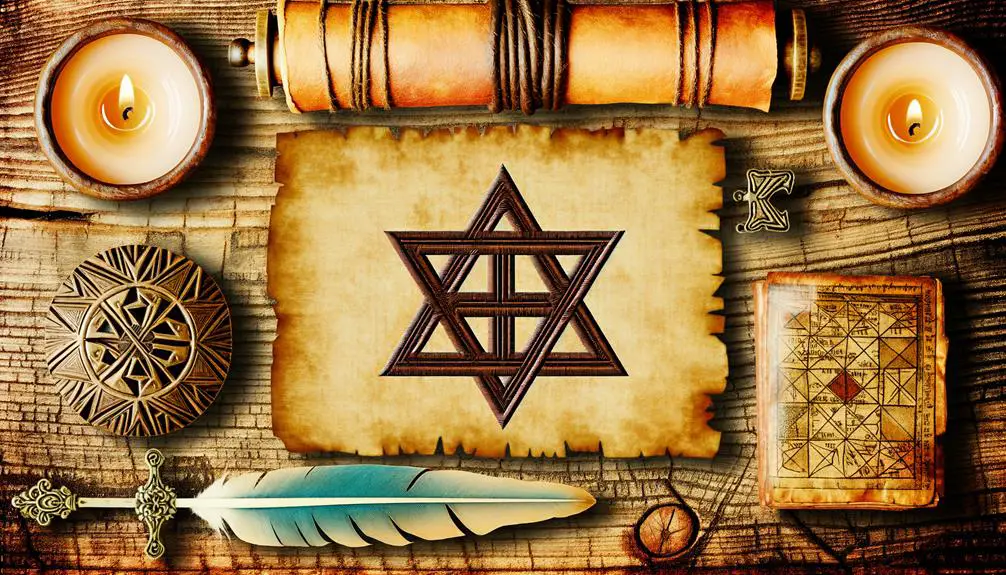
The historical origins of the cross inside a triangle symbol can be traced back to ancient civilizations, where it often held significant religious and esoteric connotations. This emblem appears in various cultural artifacts and texts, signifying a synthesis of cosmological and metaphysical principles.
For instance, in ancient Egypt, the triangle symbolized the trinity of gods, while the cross represented the intersection of earthly and divine domains. Similarly, in early Mesopotamian societies, the combination of these shapes was imbued with meanings related to creation and the interplay of natural forces.
Scholarly investigations reveal that this symbol served as a potent emblem of unity, balance, and the convergence of different dimensions of existence, reflecting a profound understanding of the interconnectedness of life and the universe.
Religious Significance
Reverence for the cross inside a triangle symbol permeates various religious traditions, where it embodies profound spiritual doctrines and theological concepts.
In Christianity, this symbol often represents the Holy Trinity—Father, Son, and Holy Spirit—with the triangle signifying unity and the cross denoting salvation. The intersection of the two shapes highlights the interconnectedness of divine attributes.
In Hinduism, it may symbolize the union of the physical and the spiritual, aligning with the Trimurti—Brahma, Vishnu, and Shiva. Additionally, esoteric traditions interpret this symbol as a convergence point of cosmic energies, representing balance and harmony.
Therefore, the cross within a triangle serves as a visual encapsulation of complex theological principles across diverse religious landscapes.
Alchemical Interpretations
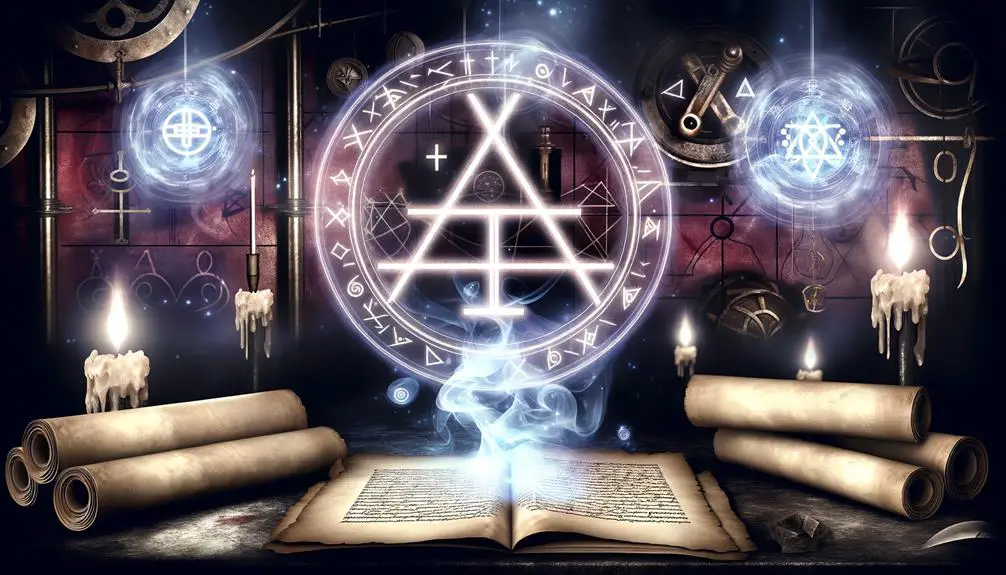
Beyond its religious connotations, the cross inside a triangle also holds significant alchemical interpretations, where it symbolizes the synthesis of elements and the pursuit of the philosopher's stone.
In alchemy, the triangle represents the three essential principles: sulfur, mercury, and salt, which constitute the foundation of all matter. The cross, intersecting within the triangle, denotes the union of these principles, achieving balance and transformation.
This amalgamation is central to the alchemist's quest for the philosopher's stone, a mythical substance believed to perfect any substance or element it touches.
The cross inside a triangle becomes a visual metaphor for the alchemical process itself, encapsulating the transformative journey towards ultimate knowledge and enlightenment.
Symbolism in Christianity
In Christian symbolism, the cross inside a triangle is often interpreted as representing the Holy Trinity, with the triangle signifying the Father, Son, and Holy Spirit, and the cross symbolizing the sacrificial crucifixion of Jesus Christ.
This emblem encapsulates core theological tenets, merging the omnipresence and unity of the Godhead with the redemptive act of Christ.
The triangle's three sides denote the co-equal, co-eternal nature of the Trinity, while the cross at the center emphasizes the pivotal event of salvation history.
By integrating these elements, the symbol serves as a profound visual catechism, promoting doctrinal reflection and spiritual contemplation.
This confluence of geometric and Christological imagery underscores the complexity and depth of Christian theological symbolism.
Freemasonry Connections
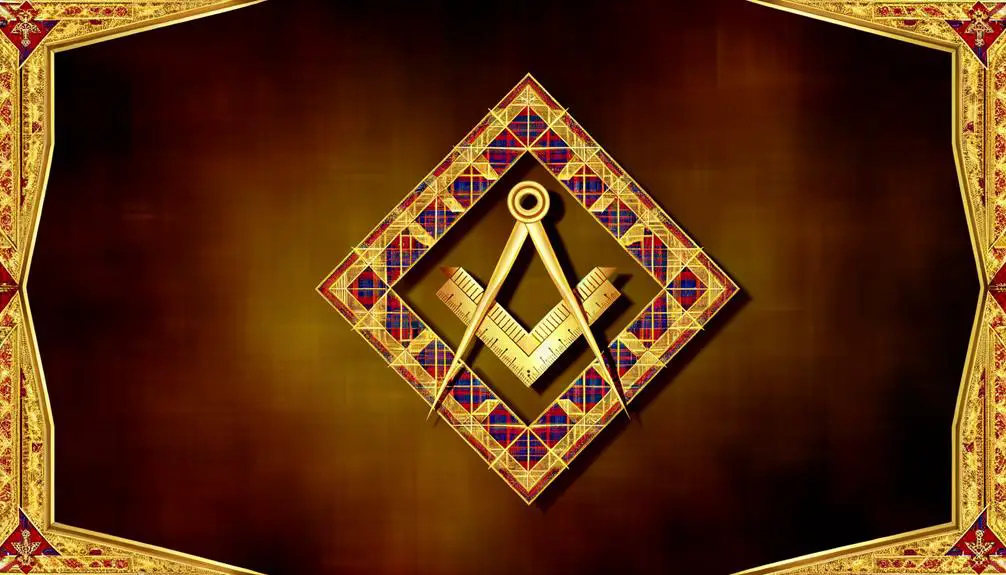
Although often associated with religious symbolism, the cross inside a triangle also holds significant meaning within Freemasonry, where it embodies esoteric knowledge and the pursuit of moral and spiritual enlightenment. This symbol reflects the Masonic belief in the perfect balance of spiritual, intellectual, and material domains.
The triangle represents the triune nature of human existence, while the cross signifies the intersection of the earthly and divine.
Key aspects of the symbol within Freemasonry include:
- Triadic Harmony: Symbolizes balance among body, mind, and spirit.
- Moral Rectitude: Represents the adherence to a higher ethical standard.
- Enlightenment: Signifies the journey towards greater wisdom and understanding.
- Unity of Opposites: Embodies the reconciliation of material and spiritual pursuits.
This synthesis underscores Freemasonry's dedication to holistic self-improvement.
Occult and Mysticism
The cross inside a triangle, beyond its Freemasonic implications, also holds profound significance in the domains of occult and mysticism, where it is revered as a powerful emblem of esoteric wisdom and the union of cosmic forces.
This symbol is often interpreted as the convergence of the material and spiritual domains, with the triangle representing the triadic nature of existence—body, mind, and spirit—and the cross symbolizing the intersection of divine and earthly planes. It embodies the alchemical process of transformation, hinting at the transcendence of the mundane to achieve enlightenment.
In mystic traditions, the cross within the triangle is seen as a key to accessing hidden knowledge, serving as a guidepost for spiritual seekers on their quest for ultimate truth.
Cross-Cultural Perspectives
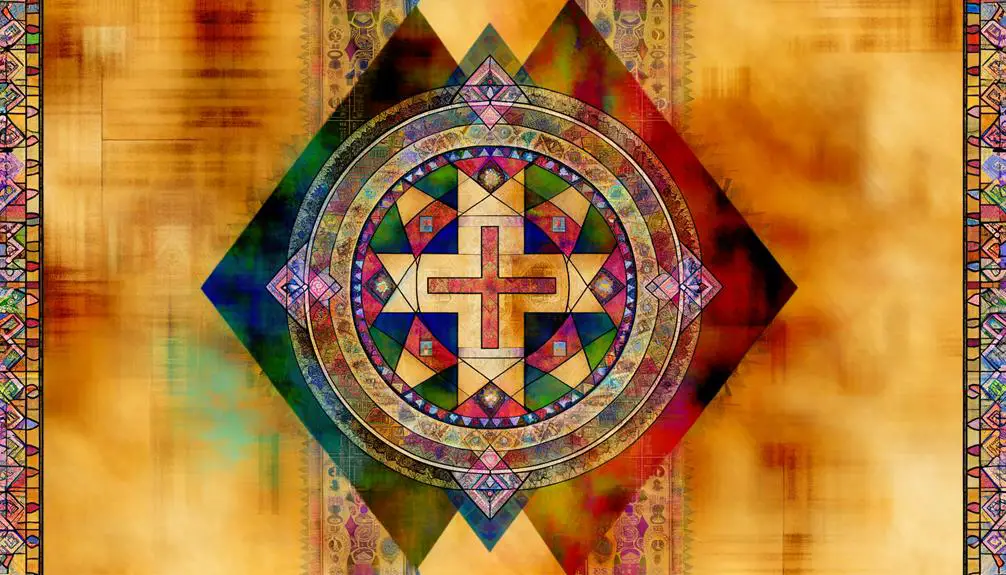
Examining the cross inside a triangle from a cross-cultural perspective necessitates an exploration of its varied symbolism in religious contexts, such as Christianity, Hinduism, and ancient Egyptian spirituality.
Historically, this symbol has been interpreted differently across civilizations, reflecting unique cultural narratives and spiritual understandings.
Moreover, its artistic representations reveal profound insights into the shared and divergent meanings attributed to this symbol across diverse cultures.
Symbolism in Various Religions
Many religions and spiritual traditions incorporate the cross inside a triangle symbol, which often represents the intersection of divinity and humanity, and is imbued with a multitude of nuanced meanings.
This symbol is a profound embodiment of theological concepts and spiritual truths across various cultures.
- Christianity: The triangle signifies the Holy Trinity (Father, Son, Holy Spirit), with the cross representing the sacrifice of Jesus Christ.
- Hinduism: The symbol can signify the Trimurti (Brahma, Vishnu, Shiva) within the cosmic order.
- Freemasonry: It symbolizes the union of the spiritual and material worlds.
- Alchemy: Represents the philosopher's stone, combining earth, air, fire, and water, indicating transformation and enlightenment.
These interpretations highlight the symbol's rich, multifaceted nature across different spiritual landscapes.
Historical Interpretations Worldwide
Across diverse historical contexts, the cross inside a triangle symbol has held significant meanings, reflecting the interplay of cultural, spiritual, and philosophical paradigms. This symbol's interpretations vary widely, influenced by the specific historical and cultural milieus in which it appears. For instance, in ancient Egypt, it was associated with the concept of cosmic order and divine protection. In medieval Europe, it represented the Holy Trinity, a core Christian doctrine. Indigenous cultures in the Americas saw the symbol as embodying the union of earth, sky, and the underworld.
| Culture | Historical Period | Interpretation |
|---|---|---|
| Ancient Egypt | Pharaonic Era | Cosmic Order, Divine Protection |
| Medieval Europe | Middle Ages | Holy Trinity, Christian Doctrine |
| Indigenous Americas | Pre-Columbian Era | Union of Earth, Sky, and Underworld |
| East Asia | Classical Antiquity | Harmony of Heaven, Earth, and Humanity |
These interpretations underscore the symbol's multifaceted significance across different civilizations.
Artistic Representations Cross-Culturally
Building on the diverse historical interpretations of the cross inside a triangle symbol, its artistic representations across various cultures reveal profound insights into the aesthetic and symbolic values attributed to it through different mediums. This emblem is often utilized in art to convey sacred geometry, spiritual beliefs, and philosophical ideologies.
For instance, its presence in Egyptian hieroglyphs and Christian iconography showcases its adaptability and enduring significance.
- Egyptian Art: Symbolizes the union of cosmic elements.
- Christian Iconography: Represents the Holy Trinity and Christ's crucifixion.
- Hindu Mandalas: Embodies the integration of spiritual and material domains.
- Modern Art: Explores abstract interpretations and personal symbolism.
These varied artistic expressions underscore the symbol's universal resonance and capacity to transcend cultural boundaries.
Modern Usage
In contemporary settings, the cross inside the triangle has gained prominence in popular culture, often seen in films, music, and digital media as a symbol imbued with various interpretations. Its geometric simplicity and inherent symbolism have also made it a favored element in design and branding, where it is utilized to evoke notions of mysticism, balance, and innovation.
This modern appropriation underscores a complex interplay between traditional meanings and contemporary aesthetic and commercial motivations.
Popular Culture References
The cross inside a triangle symbol has permeated various facets of modern popular culture, often appearing in films, television series, and video games, where it frequently signifies hidden knowledge, secret societies, or mystical powers. This symbol serves as a narrative device, representing arcane wisdom, clandestine organizations, or supernatural forces, thereby adding layers of intrigue and depth to storytelling.
Such usage not only reflects its historical connotations but also recontextualizes it within contemporary narratives, making it relevant to modern audiences.
- Films: Utilized to denote secret organizations or ancient prophecies.
- Television Series: Often signifies hidden agendas or mystical elements.
- Video Games: Used to mark locations with hidden treasures or quests.
- Literature: Symbolizes esoteric knowledge or secretive groups.
Design and Branding
Beyond its narrative allure in popular culture, the cross inside a triangle symbol has also been appropriated in modern design and branding, where it often conveys a sense of mystery, sophistication, and exclusivity.
This geometric emblem is utilized by luxury brands, avant-garde fashion labels, and high-end technology firms to evoke an enigmatic yet elegant image. Analyzing its visual impact, the sharp angles and intersecting lines of the symbol create a focal point that captures attention, while its simplicity guarantees versatile application across various media.
In branding, this symbol functions as a semiotic tool, encapsulating complex brand identities and values within a minimalist form, thereby enhancing brand recognition and differentiation in a saturated marketplace.
Psychological Interpretations
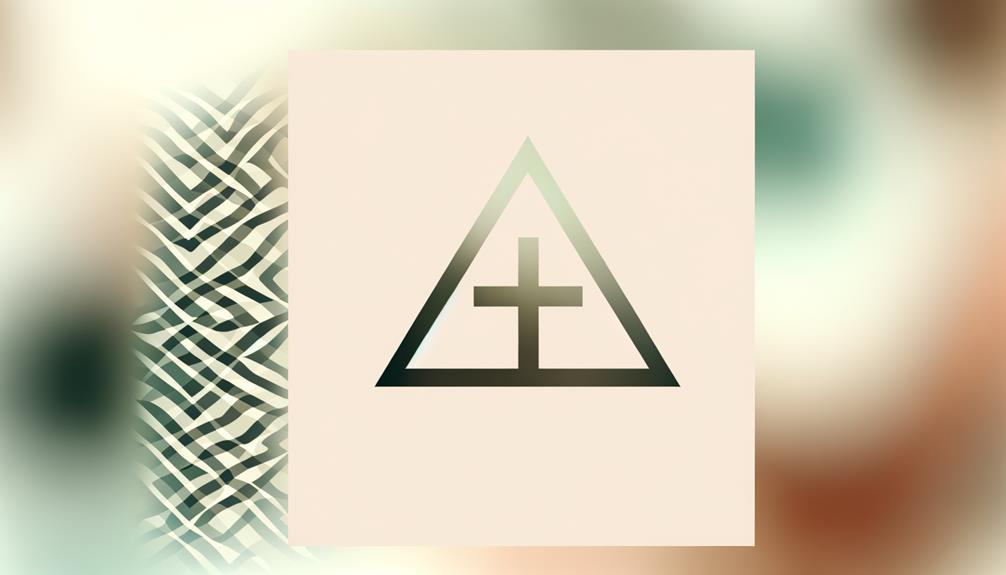
Understanding the psychological interpretations of the cross inside a triangle symbol requires an exploration of its implications in cognitive symbolism and archetypal imagery. This symbol often resonates deeply within the human psyche, evoking a myriad of subconscious associations.
- Integration of opposites: The cross symbolizes the intersection of dualities, suggesting a harmonization within the triangular boundary, which represents stability.
- Spiritual enlightenment: The triangle often signifies spiritual ascent, and the cross within it could denote the journey toward higher consciousness.
- Wholeness and unity: Combining two potent symbols, it implies a sense of completeness and the unification of mind, body, and spirit.
- Protection and guidance: Historically, such symbols have been used as amulets, indicating psychological comfort and a sense of direction.
Artistic Representations
The cross inside a triangle has been rendered with diverse artistic expressions, reflecting symbolic artistry variations that transcend mere visual representation.
Across different cultures, artists infuse the motif with unique interpretations, embedding layers of meaning that resonate with their distinct historical and philosophical contexts.
In contemporary design, this symbol often features prominently, manifesting in modern trends that emphasize minimalism while retaining profound symbolic depth.
Symbolic Artistry Variations
Artistic representations of the cross inside a triangle symbol exhibit a wide array of symbolic artistry variations, reflecting diverse cultural, religious, and philosophical interpretations. This symbol's visual expressions can range from minimalist designs to intricate patterns, each embodying unique meanings and contexts. The variations often emphasize different aspects such as spiritual enlightenment, unity, and transcendence.
- Geometric Precision: Clean lines and precise angles are used to convey order and structure.
- Ornate Embellishments: Detailed decorations may symbolize historical or theological richness.
- Abstract Forms: Deconstructed elements suggest modern philosophical interpretations.
- Color Usage: Specific color choices can emphasize particular symbolic attributes, such as purity or divinity.
These variations not only enhance the aesthetic appeal but also deepen the interpretive layers of this multifaceted symbol.
Cultural Interpretations in Art
Exploring the cultural interpretations of the cross inside a triangle symbol in art reveals the profound ways in which different societies imbue this geometric configuration with distinct meanings and values.
In Christian iconography, this symbol often represents the Holy Trinity, encapsulating the Father, Son, and Holy Spirit within the stabilizing form of the triangle.
Conversely, in alchemical and occult traditions, it is frequently seen as a synthesis of elemental and spiritual forces, with the triangle symbolizing the threefold nature of existence and the cross denoting the intersection of material and divine domains.
In Eastern philosophies, this symbol can signify balance and harmony, merging the physical and metaphysical. Each artistic representation thereby becomes a lens through which cultural paradigms are both expressed and preserved.
Modern Design Trends
In contemporary design, the cross inside a triangle symbol has emerged as a versatile motif, reflecting a confluence of historical significance and modern aesthetic sensibilities. This symbol is increasingly found in various artistic representations, serving as a bridge between traditional iconography and cutting-edge design practices. Its geometric simplicity allows it to be incorporated into a wide array of contexts, from digital media to fashion.
- Minimalist Design: Emphasizes simplicity and clean lines, often integrating this symbol for its visual clarity.
- Brand Identity: Utilized by companies to convey stability and innovation.
- Graphic Design: Featured in logos and digital art, offering a timeless yet contemporary appeal.
- Tattoo Art: Chosen for its symbolic depth and aesthetic versatility.
This fusion of historical and modern elements enhances its adaptability and resonance in today's visual culture.
Personal Reflections
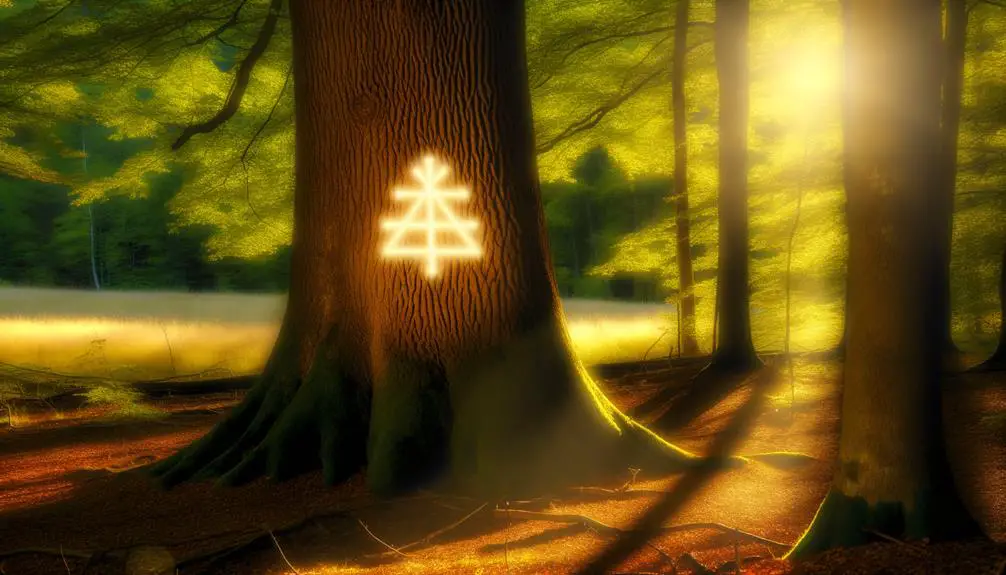
Reflecting on the cross inside triangle symbol, one must consider the profound personal and cultural implications it holds for individuals across different societies. This symbol, often laden with historical, spiritual, and philosophical connotations, resonates deeply within personal belief systems.
Its intersection of geometrical simplicity and complex meaning invites introspection, rendering it a potent emblem for self-discovery and existential reflection. On a cultural level, it embodies collective narratives and shared heritage, thereby fostering communal identity and continuity.
Conclusion
The cross inside a triangle is a symbol rich in historical, religious, alchemical, and artistic significance. It serves as a multifaceted emblem across various domains. This trifecta of lines and angles is not merely a geometric figure but a tapestry woven with threads of ancient wisdom, spiritual depth, and modern reinterpretations.
Like a prism refracting light into a spectrum, this symbol encompasses diverse meanings, reflecting the complexity of human thought and belief systems through centuries.






